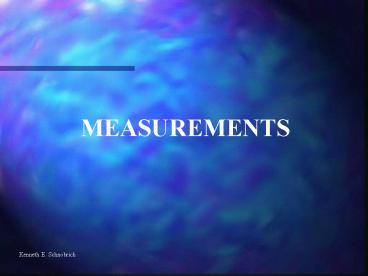MEASUREMENTS - PowerPoint PPT Presentation
1 / 19
Title:
MEASUREMENTS
Description:
MASS TIME 4 ... Balance TIME Interval between 2 events Second Timer/clock TEMP. Measure of avg. K.E. C or K thermometer BASIC vs DERIVED Basic Units or Fundamental ... – PowerPoint PPT presentation
Number of Views:62
Avg rating:3.0/5.0
Title: MEASUREMENTS
1
MEASUREMENTS
Kenneth E. Schnobrich
2
WHAT DO WE HAVE TO DO?
- WE MUST DEFINE WHAT IT IS WE ARE GOING
- TO MEASURE
2. WE MUST ESTABLISH A STANDARD
- WE MUST DEVELOP SOMETHING TO COMPARE
- TO THE STANDARD
3
NORMAL MEASUREMENTS
- LENGTH
2. MASS
- TIME
4. TEMPERATURE
4
TYPICAL UNITS
UNIT DEFINITION STD COMPARE
LENGTH Dist. Between 2 points Meter Metric rule
MASS Quantity of matter grams or kilograms Balance
TIME Interval between 2 events Second Timer/clock
TEMP. Measure of avg. K.E. C or K thermometer
5
BASIC vs DERIVED
- Basic Units or Fundamental Units are those we
just mentioned - Length
- Mass
- Time
- Temperature
6
BASIC vs DERIVED
- Derived Units are combinations of the basic units
- Area L x W
- Volume L x W x H
- Density Mass/Volume
- Energy Joule (kgm2/s2) or calorie
- Pressure Pa kg/ms2
7
WHY THE METRIC SYSTEM?
BASED ON DIVISIONS OF OR MULTIPLES OF TEN
THERE ARE COMMON PREFIXES
THE SYSTEM IS WIDELY ACCEPTED
8
COMMON PREFIXES
Prefix Symbol Meaning Exp. Not.
Mega M 1,000,000. 106
Kilo k 1,000. 103
Hecto h 100. 102
Deca D 10. 101
Deci d 0.1 10-1
Centi c 0.01 10-2
Milli m 0.001 10-3
Micro µ 0.000001 10-6
Nano n 0.00000001 10-9
9
UNIT CONVERSIONS
Convert 25.4 kg to g
25.4 kg
x
(1000 g/kg)
25400 g
Convert 8500 m to mm
8500 m
x
(1000 mm/m)
8500000 mm
10
WHAT IS A SIGNIFICANTFIGURE?
When you are making a measurement there are
always a certain number of known or certain
digits.
Then as part of the measurement there will always
be a digit that is uncertain because it is your
guess.
The known or certain digits plus the first
unknown Digit are referred to as the SIGNIFICANT
FIGURES
11
PRECISION vs ACCURACY
PRECISION this refers to a situation where the
same result is gotten each time you perform the
operation repeatedly hitting the same spot in
darts
ACCURACY this refers to how close you come to
the accepted value or result how close you
are to the bullseye
12
SIGNIFICANT FIGURES
The following rules apply to significant figures
- All digits in a measurement are considered
significant - Zeros that fall between digits are considered
significant - Zeros to the right of a decimal and to the left
of a non-zero are considered significant - If a decimal point is placed after a zero all of
the intervening zeros are significant - Zeros after a digit but not followed by a decimal
are not significant
13
EXACT NUMBERS
These are usually numbers that are obtained by
counting rather than using a measuring device
such as a buret or graduated cylinder - 12 eggs
in a dozen, 2 socks in a pair, 144 things in a
gross
14
SIGNIFICANT FIGURES
Working with Significant figures
- When you add or subtract numbers
- the final answer can have no more decimal
places than the least precise value in the
operation
2. When you multiply or divide numbers the
final answer can have no more significant figures
than the smallest number of significant figures
in the operation
15
EXAMPLES
ADDING SUBTRACTING
5.0043 4.032 1.02 3.2
5.0043 1.02
4.02
13.3
16
EXAMPLES
Multiplying and Dividing
4.91
5.0043 4.032
5.0043
1.02
20.33
17
MORE EXAMPLES
How many Significant figures in each of the
following
1. 0.0043
2. 1.0043
3. 14300
4. 5820.
5. 30089
6. 2.0607
18
MORE EXAMPLES
How many Significant figures in each of the
following
1. 243.0 x 1.8
2. 1.0043 2.08
3. 14300/4
4. 5820. x 4.32
5. 30089 - 7.32
6. 2.0607 3.85
19
ROUNDING
- When rounding use only the first digit to the
right of the last significant figure . 4.348
becomes 4.3 if rounded to 2 sig.figs. - Rules
- In a series of calculations, carry the extra
digits through to the final result, then round. - If the digit to be removed
- Is less than 5 the preceding digit stays the
same. 1.33 becomes 1.3 - Is equal to or greater than 5, the preceding
digit is increased by 1. 1.36 becomes 1.4































